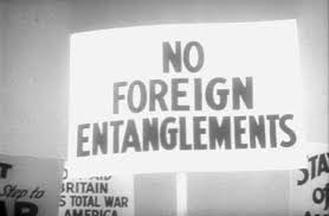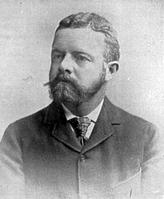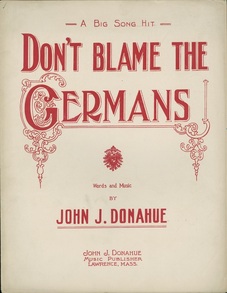LESSON 7.1: U.S. ISOLATIONISM
YOUR MISSION
Know what you will be able to do when the lesson is over.
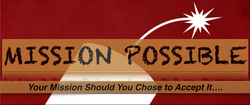
I can explain American isolationism after World War I.
YOUR PORTFOLIO
Prepare the header for your portfolio entry for today. List the entry in your table of contents.
CLASS READING
As a class, we will take turns reading the class reading below.
U.S. Isolationism
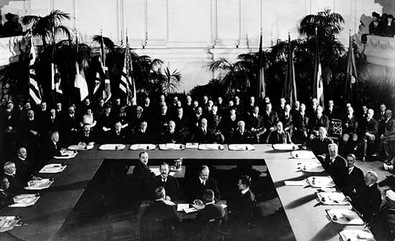 Delegates to the Washington Naval Disarmament Conference
Delegates to the Washington Naval Disarmament Conference
The major naval powers of Britain, France, Italy, Japan and the United States all met in Washington D.C. in 1921 to resolve disputes over their territories in the Pacific and to discuss reducing the size of their navies. Many pacts were made during the conference but the United States agreed to recognize other countries' territories and to reduce naval arms only a small amount. Though the United States realized that there was little need for a big navy if they planned on staying out of foreign affairs and remaining neutral, they had learned a lesson from World War I. Neutral countries needed to be able to defend themselves well. If you will recall, Germany had agreed to respect Belgium's neutrality, but they attacked them in World War I. The U.S. was not going to take that chance. So, they did reduce the amount of battleships in the navy, but replaced the battleships with cruisers.
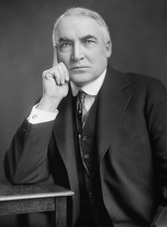 President Warren G. Harding
President Warren G. Harding
President Warren G. Harding passed an Emergency Tariff in May of 1921 to increase taxes on food imports, and in 1922 Congress passed the Fordney-McCumber Tariff. The Fordney-McCumber Act which was the law that passed this tariff established the highest tariffs in history. Some duties went up 400%! The average increase was 40%.
The tariff was passed to protect American factories and farms. The tariff increased the amount that foreign factory owners and farmers had to pay to sell their products in the U.S. This, in turn, increased the cost of foreign goods in America, because foreign factory owners and farmers would then have to charge people more for their goods in order to make a profit. So, when presented with less expensive American made goods and expensive imported foreign goods, people would be more inclined to chose the cheaper, American made goods.
In the long run, the Fordney-McCumber Act damaged the American economy, because other countries tried to get back at America by raising their duties on goods and stopping American exports. However, for the time being, America did not see this damage because the U.S. was a huge new world power, and there was plenty of demand at home.
The tariff was passed to protect American factories and farms. The tariff increased the amount that foreign factory owners and farmers had to pay to sell their products in the U.S. This, in turn, increased the cost of foreign goods in America, because foreign factory owners and farmers would then have to charge people more for their goods in order to make a profit. So, when presented with less expensive American made goods and expensive imported foreign goods, people would be more inclined to chose the cheaper, American made goods.
In the long run, the Fordney-McCumber Act damaged the American economy, because other countries tried to get back at America by raising their duties on goods and stopping American exports. However, for the time being, America did not see this damage because the U.S. was a huge new world power, and there was plenty of demand at home.
DISCUSSION QUESTIONS
As a class, we will discuss the questions. You will answer these questions in your portfolio in PQA format. An example portfolio entry is embedded below.
- Why did the United States break their policy of isolationism before World War I?
- How did the United States practice isolationism after World War I?
- Why did many people want to stay out of the League of Nations?
- What did the United States learn from World War I?
- How did the lesson that Americans learned in World War I effect decisions they made at the Washington Disarmament Conference?
U.S. ISOLATIONISM QUIZ
|
On your own, answer the quiz questions in the quiz below. When you finish the quiz write the answers in your portfolio. I have set up the questions for you in the sample portfolio below. You will need to add the answers. To take the quiz, click on the quiz icon to the right.
|
LESSON REFLECTION
|
As the last section in your portfolio question write a paragraph summary explaining American isolationism after World War I. A sample portfolio entry is embedded below.
Remember, when you write a paragraph to follow the proper paragraph structure below:
You need help with structure click on the icon to the right to read about, How to Write a Paragraph. |
Name Homeroom
Lesson 7.1: U.S. Isolationism
Lesson Mission: I can explain American isolationism after World War I.
Discussion Questions:
1. The United States broke their policy of isolationism before World War I because
__________________________________________________________________________________.
2. The U.S. practiced isolationism after World War I by _____________________________
__________________________________________________________________________________.
3. Many people wanted to stay out of the League of Nations because _____________
__________________________________________________________________________________.
4. The U.S. learned ________________________________________________________________
____________________________________________________________ from World War I.
5. It is obvious that the lessons that the U.S. learned from World War I effected the
decisions they made at the Washington Disarmament Conference because ____
__________________________________________________________________________________.
Quiz Questions:
1. What is isolationism? ___________________________________________________________.
2. What is a tariff? _________________________________________________________________.
3. What is a quota? _______________________________________________________________.
4. What is an embargo? ___________________________________________________________.
5. What are imports? ______________________________________________________________.
6. What are exports? ______________________________________________________________.
7. What was the Fordney-McCumber Tariff? _______________________________________.
8. What was the Washington Naval Disarmament Conference? ___________________.
9. Which countries were involved in the Washington Naval Disarmament
Conference? ____________________________________________________________________.
10. Who was the Republican Speaker of the House under Woodrow Wilson who
opposed (did not like) Wilson's idea of a League of Nations? ___________________.
Lesson Reflection
(Explain American Isolationism after World War I in your own words.)
LESSON CHECKLIST

You have accomplished your mission after you have done the following. If you are absent, you need to do the following to complete your missed work.
- Read the class reading.
- Create a portfolio entry.
- List the portfolio entry in your table of contents.
- Answer the discussion questions in your portfolio.
- Take the Lesson 7.1. U.S. Isolationism Quiz.
- Record the quiz questions and answers in your portfolio.
- Complete the lesson reflection in your portfolio.
- If you finish early, go ahead and start studying for the test by playing the Lesson 7.1. U.S. Isolationism Games.
Click on any of the blue game titles to play that game.
